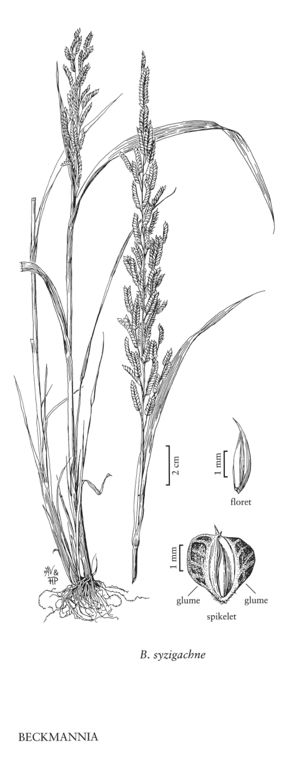Difference between revisions of "Beckmannia syzigachne"
FNA>Volume Importer |
imported>Volume Importer |
||
| Line 24: | Line 24: | ||
-->{{Treatment/Body | -->{{Treatment/Body | ||
| − | |distribution=Wash.;Wis.;Wyo.;N.Mex.;N.Y.;Pa.;Calif.;Nev.;Colo.;Alaska;Ill.;Iowa;Ariz.;Idaho;N.Dak.;Nebr.;S.Dak.;Maine;Ohio;Utah;Mo.;Minn.;Mich.;Kans.;Mont.;Alta.;B.C.;Greenland;Nfld. | + | |distribution=Wash.;Wis.;Wyo.;N.Mex.;N.Y.;Pa.;Calif.;Nev.;Colo.;Alaska;Ill.;Iowa;Ariz.;Idaho;N.Dak.;Nebr.;S.Dak.;Maine;Ohio;Utah;Mo.;Minn.;Mich.;Kans.;Mont.;Alta.;B.C.;Greenland;Nfld. and Labr. (Nfld.);Man.;N.B.;N.S.;N.W.T.;Nunavut;Ont.;P.E.I.;Que.;Sask.;Yukon;Oreg. |
|discussion=<p><i>Beckmannia syzigachne</i> grows in damp habitats such as marshes, floodplains, the edges of ponds, lakes, streams, and ditches, and in standing water. It is a good forage grass, but frequently grows in easily damaged habitats.</p> | |discussion=<p><i>Beckmannia syzigachne</i> grows in damp habitats such as marshes, floodplains, the edges of ponds, lakes, streams, and ditches, and in standing water. It is a good forage grass, but frequently grows in easily damaged habitats.</p> | ||
|tables= | |tables= | ||
| Line 42: | Line 42: | ||
|illustrator=Linda Ann Vorobik;Hana Pazdírková | |illustrator=Linda Ann Vorobik;Hana Pazdírková | ||
|illustration copyright=Utah State University | |illustration copyright=Utah State University | ||
| − | |distribution=Wash.;Wis.;Wyo.;N.Mex.;N.Y.;Pa.;Calif.;Nev.;Colo.;Alaska;Ill.;Iowa;Ariz.;Idaho;N.Dak.;Nebr.;S.Dak.;Maine;Ohio;Utah;Mo.;Minn.;Mich.;Kans.;Mont.;Alta.;B.C.;Greenland;Nfld. | + | |distribution=Wash.;Wis.;Wyo.;N.Mex.;N.Y.;Pa.;Calif.;Nev.;Colo.;Alaska;Ill.;Iowa;Ariz.;Idaho;N.Dak.;Nebr.;S.Dak.;Maine;Ohio;Utah;Mo.;Minn.;Mich.;Kans.;Mont.;Alta.;B.C.;Greenland;Nfld. and Labr. (Nfld.);Man.;N.B.;N.S.;N.W.T.;Nunavut;Ont.;P.E.I.;Que.;Sask.;Yukon;Oreg. |
|reference=None | |reference=None | ||
|publication title= | |publication title= | ||
|publication year= | |publication year= | ||
|special status= | |special status= | ||
| − | |source xml=https:// | + | |source xml=https://bibilujan@bitbucket.org/aafc-mbb/fna-data-curation.git/src/bb6b7e3a7de7d3b7888a1ad48c7fd8f5c722d8d6/coarse_grained_fna_xml/V24/V24_698.xml |
|subfamily=Poaceae subfam. Pooideae | |subfamily=Poaceae subfam. Pooideae | ||
|tribe=Poaceae tribe Poeae | |tribe=Poaceae tribe Poeae | ||
Revision as of 21:49, 27 May 2020
Plants annual; tufted. Culms 20-120 cm. Ligules 5-11 mm, pubescent, entire or lacerate, usually folded back; blades 4-10(20) mm wide, flat, scabrous. Panicles 7-30 cm; branches spikelike, usually 1-2 cm. Spikelets 2-3 mm, round to ovate in side view, with 1 floret, a second undeveloped or well-developed floret occasionally present. Glumes appearing inflated, strongly keeled, 3-veined, apiculate; lemmas 2.4-3.5 mm, unawned, sometimes mucronate; paleas subequal to the lemmas, acute; anthers 0.5-1(1.5) mm, pale yellow. Caryopses shorter than 2 mm, light to medium brown. 2n = 14.
Distribution
Wash., Wis., Wyo., N.Mex., N.Y., Pa., Calif., Nev., Colo., Alaska, Ill., Iowa, Ariz., Idaho, N.Dak., Nebr., S.Dak., Maine, Ohio, Utah, Mo., Minn., Mich., Kans., Mont., Alta., B.C., Greenland, Nfld. and Labr. (Nfld.), Man., N.B., N.S., N.W.T., Nunavut, Ont., P.E.I., Que., Sask., Yukon, Oreg.
Discussion
Beckmannia syzigachne grows in damp habitats such as marshes, floodplains, the edges of ponds, lakes, streams, and ditches, and in standing water. It is a good forage grass, but frequently grows in easily damaged habitats.
Selected References
None.
